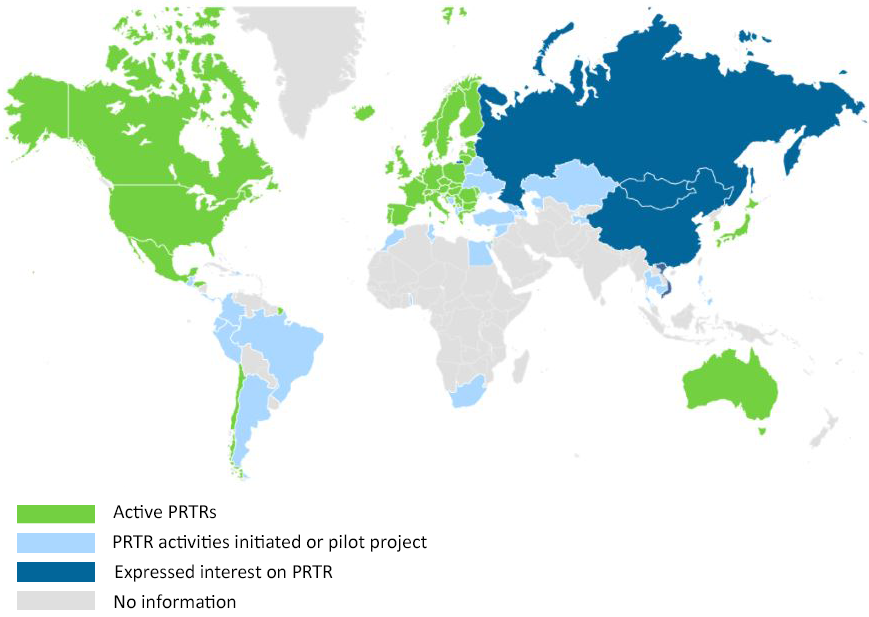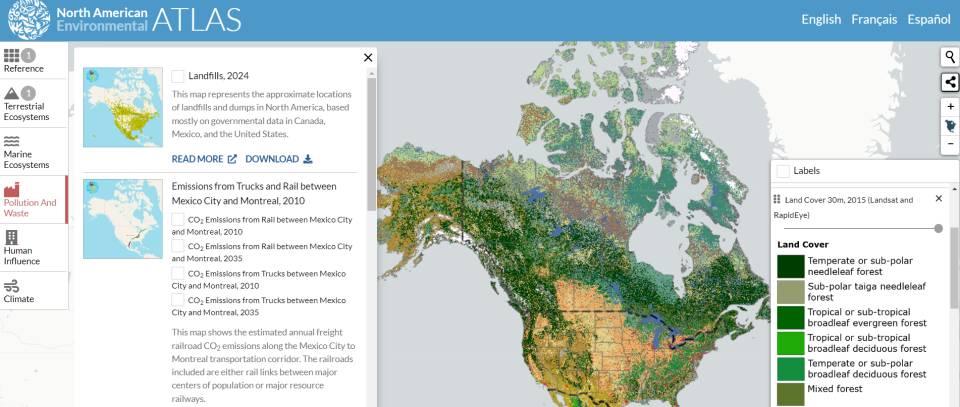TRI Around the World
- What are PRTRs?
- How does the TRI Program support other countries?
- Which international organizations does the TRI Program collaborate with?
What are PRTRs?
Pollutant Release and Transfer Registers (PRTRs) are publicly accessible databases or inventories that track releases of pollutants into the environment and transfers of pollutants off site for disposal or other waste management methods. PRTRs shed light on how industrial facilities manage and dispose of chemical waste generated in the course of their operations. One of the primary purposes of these systems is to improve transparency regarding pollutant releases and transfers to better inform decision-making by policymakers, scientists, industry representatives, and others.
The Toxics Release Inventory (TRI) is the U.S. PRTR system. It was created in 1986, and was the first PRTR system in the world. Since then, many countries have set up PRTRs following the TRI model. Currently, at least 50 countries have fully established PRTRs or have implemented pilot programs, as shown in the map below. Many more PRTRs are expected to be developed in the coming years, particularly in Asian and South American countries.

Variability Among PRTRs
International PRTRs differ in their design and implementation. The differences account for individual country circumstances, such as existing regulations, programmatic resources, and the types of industry in the country. The variations include:
- Industry sectors covered
- Chemicals covered
- Reporting thresholds (chemical, sector, employment thresholds)
- Granularity of release data elements
- Years of data available
These differences are important to consider when comparing data at a regional or global level. Granularity and data availability are particularly important because they tend to limit the comparability of data across PRTRs. All of these factors, however, are important context for the conclusions of any analysis.
How Does the TRI Program Support Other Countries?
As a global leader in PRTR, EPA's TRI Program:
- Advises countries who want to set up their own TRI-like programs, and
- Supports efforts to increase data availability, comparability, and reliability in PRTR systems around the world.
The TRI Program’s collaboration efforts focus on:
- Capacity building: Assisting in the development of new PRTR programs in other countries;
- Supporting continuous improvement: Providing reference materials that assist with continual improvements to other PRTR systems;
- Harmonization: Encouraging adoption of the OECD harmonized lists of sectors and chemicals across PRTRs; and
- Global sustainability: Promoting the use of PRTR data as part of a holistic approach to chemical management, pollutant information collection, and data transparency.
As a result of these efforts, a variety of resources for PRTR programs are now available. The PRTR community works together to increase data comparability, allowing for better analyses on a continental or global scale, such as using PRTR data to assess progress towards sustainability goals.
Which International Organizations Does the TRI Program Collaborate With?
The EPA's international partners include:
- Organization for Economic Co-operation and Development
- United Nations
- Commission for Environmental Co-operation
Organization for Economic Co-operation and Development
The Organization for Economic Co-operation and Development (OECD) is made up of representatives from 38 member countries in North America, South America, Europe, and the Asia-Pacific region, as well as the European Commission. OECD regularly meets to coordinate and harmonize policies, discuss issues of mutual concern, and work together to respond to international problems.
OECD and PRTRs
In 1993, the OECD began work to encourage development of PRTRs, as a follow-up to a United Nations Conference on Environment and Development. OECD works with governments, industry, and non-governmental organizations to develop practical tools to support efforts of member countries, provide outreach to non-member countries, and coordinate international activities.
To help member countries implement efficient and effective PRTR systems, the OECD Working Party on PRTRs (WP-PRTR) provides a venue for countries with established PRTRs to share experiences and new policy and implementation developments. The WP-PRTR also works to improve the quality and specificity of PRTR information and promote use of PRTR data by collaborating on activities of mutual interest and global importance.
The WP-PRTR supports the development of PRTR programs in non-OECD countries by creating resources, such as guidance for building and maintaining a PRTR, and harmonized lists of priority pollutants and industry sectors covered by established PRTRs. Non-OECD countries planning to implement PRTRs are encouraged to partner with the Working Party for further capacity-building support.
Current OECD activities include:
- Developing methods to make international PRTR data more comparable and broadly useful;
- Cataloging global uses of PRTR data and tools; and
- Promoting the use of PRTR information to assess progress toward global sustainability.
- PRTR data are ideal for assessing progress toward the United Nations’ Sustainable Development Goals (SDGs), such as Goal 12 (target 12.4). The WP-PRTR initiated a project in 2017 to develop a methodology for analyzing PRTR data from multiple national and regional programs to quantitatively assess progress towards meeting SDG Target 12.4. The results were published in 2021 in the Report on Using PRTR Information to Evaluate Progress Towards Sustainable Development Goal 12.
United Nations
UNITAR and PRTRs
The United Nations Institute for Training and Research (UNITAR) works with developing countries to implement new environmental programs and to provide knowledge and technologies from nations with established environmental programs. UNITAR’s PRTR platform offers numerous resources, including an extensive library of digital documents and training videos. It also maintains the IOMC (Inter-Organization Programme for the Sound Management of Chemicals) Toolbox, which can help countries identify the most appropriate and efficient ways to address specific national problems related to chemicals management.
UNITAR also helps to promote networking among PRTR countries and is currently working with several partners to institute PRTRs in Argentina, Azerbaijan, Belarus, Cambodia, Chile, Ecuador, Kazakhstan, Moldova, Mongolia, Peru, and Ukraine.
UN Mandate on Toxics and Human Rights
In 1995, the UN Commission on Human Rights established the mandate to examine the human rights implications of exposure to hazardous substances and toxic waste. In 2011, the UN Human Rights Council affirmed that hazardous substances and waste may constitute a serious threat to the full enjoyment of human rights. It expanded the mandate to include the whole lifecycle of hazardous products, from manufacturing to final disposal.
In September 2024, the UN published, "Pollution Information Portals: Strengthening Access to Information on Releases of Hazardous Substances." This report describes the value of pollutant information portals, such as PRTR systems, in providing actionable data to a variety of stakeholders, making them an important component of good environmental governance and industrial sustainability.
Commission for Environmental Cooperation
The North American Commission for Environmental Cooperation (CEC) was established in 1994 under the North American Agreement on Environmental Cooperation (NAAEC), to address regional environmental concerns, help prevent potential trade and environmental conflicts, and to promote the effective enforcement of environmental law. The Agreement complements the environmental provisions of the North American Free Trade Agreement (NAFTA).
CEC and PRTRs
Three countries and their respective PRTRs are affiliated with the CEC:
- Canada's National Pollutant Release Inventory (NPRI), maintained by Environment and Climate Change Canada (ECCC);
- Mexico's Registro de Emisiones y Transferencia de Contaminantes (RETC), maintained by the Ministry of Environment and Natural Resources (Secretaría de Medio Ambiente y Recursos Naturales-SEMARNAT); and
- the U.S.'s TRI Program, managed by the Environmental Protection Agency.
The CEC publishes Taking Stock, its flagship report series presenting data and analyses of pollutant releases and transfers reported by North American facilities. The report, as well as the integrated database featuring North American PRTR data, maps, and search tools, can be explored through the CEC's Taking Stock Online website.
CEC's North American Environmental Atlas
The North American Environmental Atlas lets users explore environmental issues in Canada, the U.S., and Mexico.


